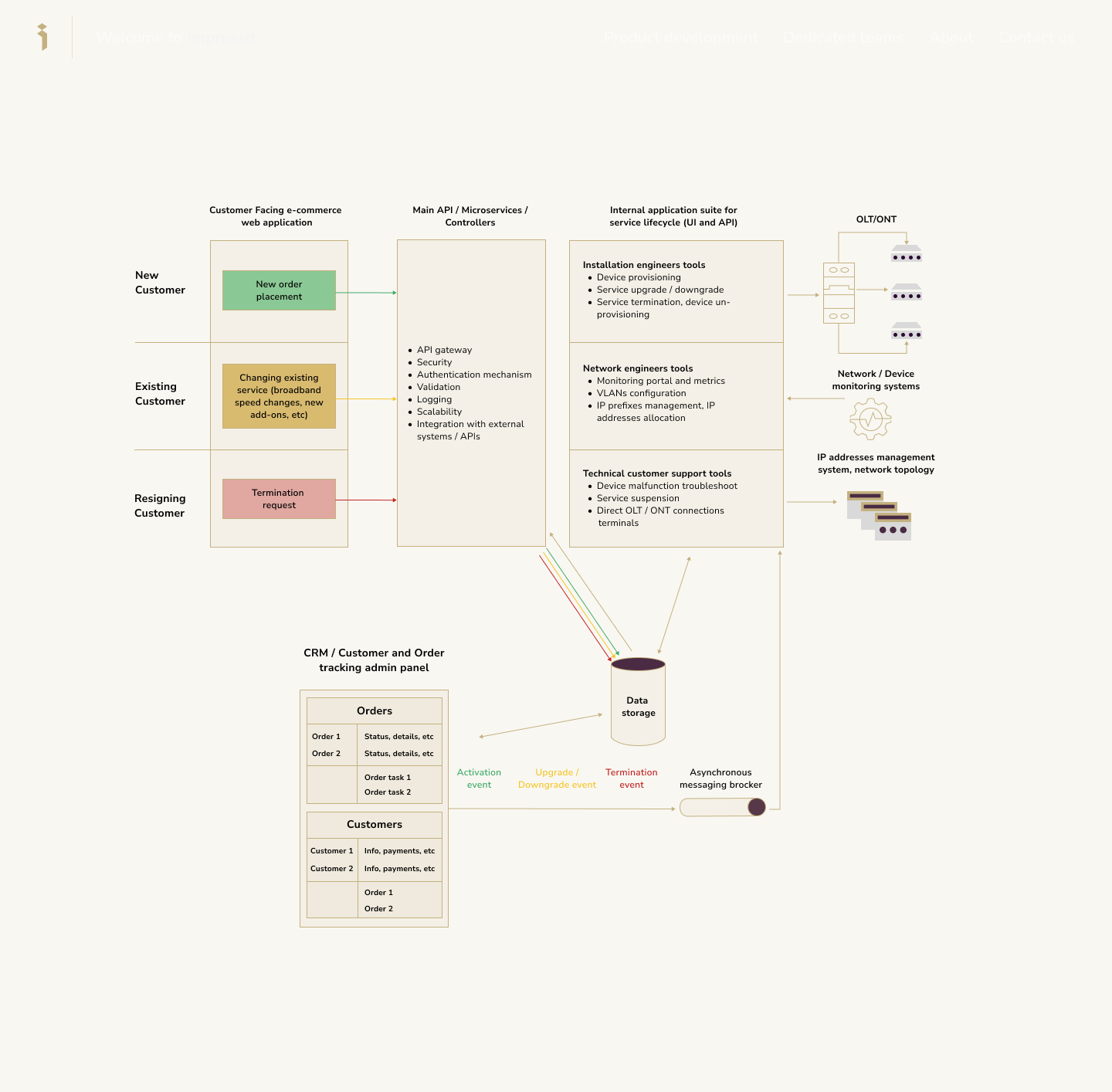Customer Life Cycle Management Solution for ISP

Customer Life Cycle is our solution that optimizes the operations of any internet service provider, such as connecting or disconnecting the customer, billing them, changing the service plan, monitoring the network status, and so on. This particular Customer Life Cycle solution, which is described in the article, is for retail customers. However, we also offer a similar system for wholesale customers.
The solution can be divided into four main blocks. The first one is the Customer Facing Application — an ISP’s website or portal where customers can find all the necessary information and leave the network connection request.
The second one is the main controller, the ‘brains’ of the whole system if you wish. The third one is the CRM. It varies from company to company but any company uses some kind of Customer Admin or Order Admin interface where they can monitor the number of customers, their service plans, payment statuses, and so on.
Last but not least, is the combination of various software solutions that are used inside the company to automate the Customer Life Cycle. Those are apps and tools for Installation Engineers, Network Engineers, and Technical Customer Support representatives. Accordingly, when an event appears in the system, a respective application responds to it and the respective company employee can perform the necessary actions.
The central database is also represented separately on the diagram. Our internet service provider software also includes auxiliary systems that every Internet provider needs. These systems are of use for Network Engineers and Technical Customer Support representatives.
For Network Engineers, there are integrations with various network device monitoring systems or directly with network devices that monitor their status. This solution is minimalistic and easy to operate. It is either a statistical data summary or graphs, or network map, where they see how the entire network works.
Likewise, Technical Customer Support has its own app, which helps them see the events that failed the first time and with the help of the additional functionality to understand what was wrong. In this case, an app can include an integration with logs or monitoring, or direct access through terminals to these devices.
Another thing worth mentioning is that this solution can actually be implemented as a single application suite using a Role-Based Access concept. That is, for one or another employee of the company, the application may look completely different and have access to different actions depending on their role and permission level. We integrate our internet service provider software with the system that the company uses to define roles (for instance, Active Directory or Google Suite) and open access to a certain functionality for each role.
This is beneficial because one does not need to deal with numerous small applications of the same type and can control user access by integrating our solution with the existing system used for emailing, accounts, and so on. It streamlines work, eliminates the need to spend time entering the same information in multiple applications, reduces the risk of errors, and improves security.

How It Can Be Used?/ How Does It Work?
Let us describe how the system actually works and why it is absolutely essential for your telecom business.
New Customers
The customer submits an application for connection, and this information then appears in our main controller and the CRM system. Subsequently, when the company representative clarifies all the necessary details with the client and confirms the application, they also add it to the company’s CRM system.
This action triggers the creation of an Activation Event in the system or an Activation Event is created manually by the respective employee. Then it is added to an Asynchronous Message Procurement, which is a queue that collects events. Other parts of the system subscribe to this queue, and they know how they should react to a certain event. After this Activation Event gets in this queue, it is redirected to the application for the Installation Engineers responsible for the new connections. The allocated Installation Engineer then performs all the necessary actions in the system that will automatically connect the client to the network, apply the correct configuration to the OLT and ONT, allocate the IP address (or IP address block), and create and configure a new VLAN if necessary.
After the Activation Event is done, the system updates the database and marks the client as connected. In parallel, the CRM system is also updated, and it begins to charge money from the client for the provided services.
Existing Customers
The scenario with the existing customers is pretty similar. Each customer has their own personal account page where they can make certain changes. For instance, a customer wants to change their service plan.
The sequence of events is as follows — a new request triggers the creation of some new fields in the database, which provoke the creation of certain Events. These Events appear in the Asynchronous Message Procurement queue. Notably, our system can automatically perform all the actions necessary for this Event, no user interference is needed. So this way the system is able to upgrade or downgrade the customer’s plan on the dates specified.
What Are the Benefits?
This solution was conceived and developed by people who witnessed firsthand the issues and challenges internet providers face in their day-to-day operations. And simply because we have seen and experienced this, we know how our internet service provider software might help any retail internet provider (both residential and business) in any country all over the world. Let us provide you with a few examples of which day-to-day challenges automation solves.
First of all, automation improves the flow of internal processes in the company, optimizes costs, improves time management, and makes life easier for employees and managers. Companies that automate routine processes work faster, more efficiently, and more productively. It is easier for such organizations to grow and develop because automation eliminates routine time-consuming tasks and thus allows the team to concentrate on strategy, planning, and other important processes.
Efficient Time Allocation
Without automation, connecting or disconnecting each new user to the system requires repetition of the same routine tasks, which take several hours, and numerous people are involved. In the automated system, connecting a new user takes approximately 10 minutes and the time each respective employee spends on the task decreases dramatically because there is no need to enter a lot of information manually or to transfer it by email or phone to other departments of the company.
Better Communication
Customer Life Cycle solution also improves communication between departments, because the whole team can see their own tasks, assigned teammates, and deadlines in the system and do not waste time on clarifications by phone or email. Automation saves time and accordingly optimizes the use of your other resources.
Fewer Errors and Risks
In companies that do not adopt automation and the main part of their operations are human-to-machine, and not machine-to-machine, the level of errors is quite high. And sometimes, the cost of these mistakes might also be high. With the Customer Life Cycle solution, there are only two options: either the event is performed successfully by the system or, in case of an error, the system promptly detects where and why the error occurred and the respective specialists can solve the problem fast. Because the internet service provider software includes monitoring and notification features, the ISP team does not have to spend hours determining the cause of the issue; as soon as something goes wrong, the respective employees get tickets and notifications that they have a problem to deal with. However, as we’ve mentioned before, the automation of processes significantly reduces the probability of errors as our system essentially limits the actions a certain user can do and provides them with controlled functionality.
Improved Cooperation with Vendors
Customer Life Cycle solution helps to deal with the cooperation with vendors. Let’s say, an ISP business communicates with the vendor on a daily basis via phone, messaging, and emails. A lot of information is transmitted by both parties, there are many tasks that should be followed, not to mention filling out financial and other documentation. Both parties use some kind of CRM system to keep track of their work. In this case, a lot of information is transmitted by both parties, there are many tasks that should be followed, not to mention filling out financial and other documentation. In this case, the Customer Life Cycle internet service provider software is able to connect those CRM systems with the help of our middleware system. Communication becomes more productive, it becomes easier for the parties to fulfill their obligations, and cooperation becomes as pleasant and fruitful as ever.
***
Secondly, although it may seem that automation only affects the internal processes of the company, this is not entirely the case. Automation of processes for ISPs directly affects the quality of services provided to customers. When customers are satisfied, the company's reputation remains excellent, and the business grows successfully, and can conquer the market.
Increased Level of Customer Satisfaction
Therefore, another reason to finally automate the operations of your ISP business is the increase of the customer’s satisfaction. The user can see certain summary analytics on their devices, payments, and traffic on their account on the website. This information is gathered and prepared by the Customer Life Cycle solution. Wherever and whenever they are, the users can access this information as well as manage their payment plans and accounts. Forget about making clients wait on the phone or spending the work time of your Customer Support on delivering the basic information that can otherwise be available to the customer in a few clicks. This is the opportunity to offer the customers (and your Support representatives) convenience and win their loyalty with superb quality of services.
Becoming a Stronger Competitor
Last but not least, companies that do not use the full potential that automation can offer risk seriously falling behind their competitors. In today's world, automation is essential for business growth and expansion.
Every internet provider has a website and uses some kind of CRM system. There’s nothing new about them; it’s just the way every such company operates. However, we believe that the introduction of the aforementioned events and how the system itself is maintained by these events and also a suite of internal automated applications can help certain departments of the company or roles in the company to do their work most efficiently.
So, to summarize all of the above, automating operations with our internet service provider software will allow any ISP to manage their team's time effectively, save money, and simplify the daily routine for almost every employee of the company. Not to mention, it will help to provide better and faster service to customers and increase the overall level of customer satisfaction.
What’s Next?
Our next step is the development of a rather powerful feature — a smart calendar for installation engineers. The system will respond to all activation events, it will understand where each installation engineer is at the moment (GPS trackers are installed in the vans) and how many installation engineers are available.
Having all this information, the system will build individual work calendars. The person with an admin role will be able to see a consolidated calendar of the installation team. It will also be possible to manually move some events that were automatically generated by the system. Such a feature undoubtedly simplifies the routine for both the engineers and their managers as well as helps the company to give better services to their clients.

Max Shpak
Other articles